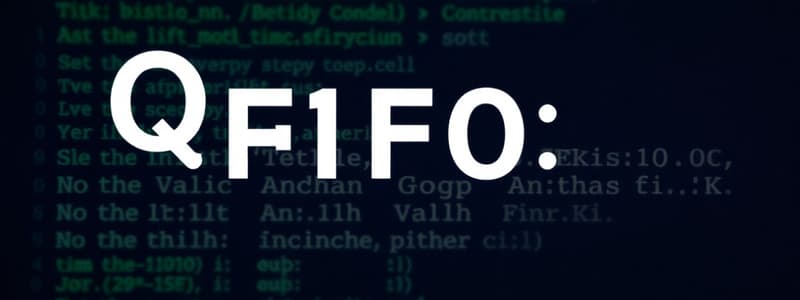Podcast
Questions and Answers
What is a Queue?
What is a Queue?
A queue is a basic data structure that follows the FIFO (first in, first out) approach.
Which of the following describes the FIFO approach?
Which of the following describes the FIFO approach?
- Last in, first out
- Random access
- First come, last served
- First in, first out (correct)
What is the operation to add an item to the queue called?
What is the operation to add an item to the queue called?
- Dequeue
- IsFull
- IsEmpty
- Enqueue (correct)
What happens when you try to dequeue from an empty queue?
What happens when you try to dequeue from an empty queue?
What is the operation to remove an item from the queue called?
What is the operation to remove an item from the queue called?
A queue is a LIFO data structure.
A queue is a LIFO data structure.
Which of the following is a typical application of queues?
Which of the following is a typical application of queues?
In a queue, the operation of adding items is called ______.
In a queue, the operation of adding items is called ______.
In a queue, the operation of removing items is called ______.
In a queue, the operation of removing items is called ______.
What is the term used when the queue has no items?
What is the term used when the queue has no items?
What is the term used for a queue that cannot accept new items?
What is the term used for a queue that cannot accept new items?
Flashcards are hidden until you start studying
Study Notes
What is a Queue?
- A queue is a linear data structure that uses a FIFO (First-In, First-Out) approach.
- The first element added to the queue is the first element removed.
- Think of a bus queue where the first person in line gets on the bus first.
Queue Applications
- Simulations & operating systems: Queues are used to manage processes waiting for execution or events.
- Buffers: Queues act as holding areas for messages between processes, programs, or systems:
- Transferring data between processes (e.g. file IO, sockets)
- Serving requests for shared resources (e.g. printer, disk, CPU)
- Call centers: Queues hold callers waiting for a service representative.
- MP3 players & Jukeboxes: Queues manage playlists.
- Real-time systems: Queues ensure interrupts are handled in the order they arrive.
Queue Structure
- Front & Rear:
- The "front" is where elements are removed.
- The "rear" is where elements are added.
- Empty Queue: When the queue is empty, both "front" and "rear" pointers are set to -1.
- Full Queue: When the "rear" pointer reaches the end of the queue, it is considered full.
Queue Operations
- Enqueue: Adds an element to the rear of the queue.
- Dequeue: Removes an element from the front of the queue.
- isEmpty: Checks if the queue is empty.
- isFull: Checks if the queue is full.
- peek: Retrieves the element at the front of the queue without removing it.
Enqueue Operation
- Steps:
- Check if the queue is full.
- If full, signal overflow error and exit.
- Increment the "rear" pointer.
- Add the element to the location pointed to by the "rear" pointer.
- Return success.
Dequeue Operation
- Steps:
- Check if the queue is empty.
- If empty, signal underflow error and exit.
- Get the element pointed to by the "front" pointer.
- Increment the "front" pointer to the next accessible element.
- Return success.
Studying That Suits You
Use AI to generate personalized quizzes and flashcards to suit your learning preferences.




